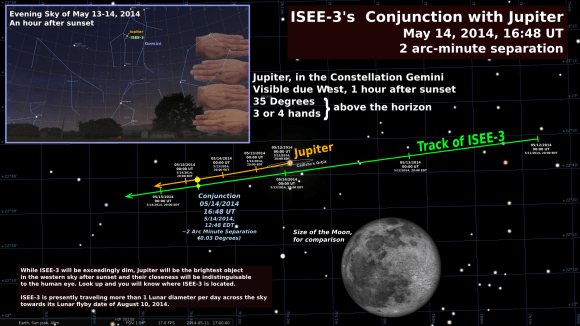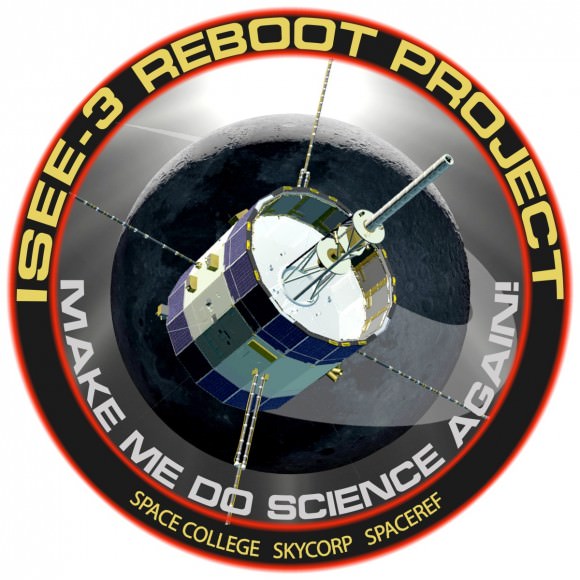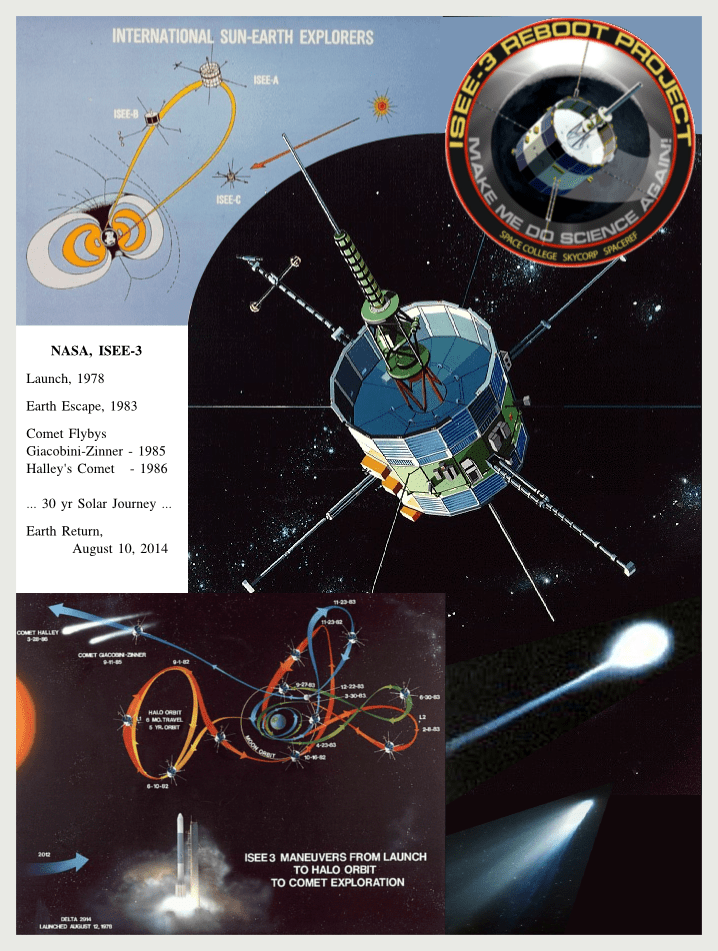Editor’s note: This guest post was written by Tim Reyes, a former NASA software engineer and analyst who has supported development of orbital and lander missions to the planet Mars since 1992.
The International Sun-Earth Explorer spacecraft (ISEE-3) is phoning home and will be returning whether we are ready or not. Launched in 1978 to study Earth’s magnetosphere, the spacecraft was later repurposed to study two comets. Now, on its final leg of a 30-plus year journey to return to Earth, there’s a crowdfunding effort called ISEE-3 Reboot aimed at reactivating the hibernating spacecraft since NASA is not offering any funding to do so.
Interestingly, on May 14th, the spacecraft will be in conjunction with the planet Jupiter, passing only 2 arc minutes from the giant gas planet. While the spacecraft is not visible to the human eye or optical telescopes, Jupiter on the 14th marks the spot where ISEE-3 resides in our night sky.

Here’s a bit of history on the program and this spacecraft in particular: The International Sun-Earth Explorers 1, 2 and 3 were the vanguard of what became an ongoing NASA program to monitor and understand the Sun-Earth relationship. ISEE-3 was part of a 3 spacecraft international effort to study the interaction of the Solar Wind with the Earth’s magnetosphere.
In 1982, NASA engineers at Goddard Space Flight Center, led by Robert Farquhar devised an unprecedented sequence of propulsion maneuvers including Earth and Moon gravitational assists to send the spacecraft ISEE-3 out of the Earth-Moon system. It was rechristened as the International Cometary Explorer (ICE) to rendezvous with two comets – Giacobini-Zinner in 1985 and Comet Halley in 1986.
The trajectory given ISEE-3 to escape the Earth-Moon system and flyby comets included returning to Earth on August 10, 2014. Final tweaks to the trajectory were completed in 1987 to assure a flyby of the Moon which Farquhar knew could be used to return ISEE-3 to an Earth orbit.

Enter the 21st Century, 30 years later and documents and magnetic tapes have predictably disappeared. The software and hardware to program, command and transmit to ISEE-3 are long gone. An independent team of engineers, led by Dennis Wingo and Keith Cowing (the same leaders of the Lunar Orbiter Image Recovery Project (LOIRP) — recovering old imagery on magnetic tape reels from the first lunar orbiter missions), operating outside the ranks and hallways of NASA are now racing against the clock to accomplish a landmark achievement: to turn on, command and maneuver a NASA spacecraft long ago abandoned, its primary missions completed in the 1980s. There are no funds, no remaining hardware or mission software to execute but this is the 21st century.
As of this writing there are five days left to contribute to this project, which is at 92% of its goal.
“ISEE-3 Reboot” team leader Dennis Wingo, says that if the efforts to contact the spacecraft are successful, plans are to return the spacecraft to the Sun-Earth L1 Point. Wingo emphasizes that Farquhar remains as instrumental to the spacecraft’s recovery today as he was to its departure, providing critical insight into the spacecraft systems.
While ISEE-3 has been on its long journey to return to Earth, remarkable technological and social events have unfolded. The personal computer arrived and matured; visionaries such as Steve Jobs have come and gone. With the Internet — non-existent when ISEE-3 launched – now a RocketHub crowdfunding effort was started to raise funds. Teleconferencing, more limited to board rooms in the days ISEE-3’s launch-date have brought retired NASA engineers and Wingo’s band of engineers together.
Amateur radio operators now have technology sufficient to acquire the signal and through the internet are also a part of the recovery effort. These events have conspired to give the band of engineers a small window of opportunity to recover the spacecraft. Additionally, without the original hardware transmitter, today’s high-speed electronics are able to emulate in software the hardware from 36 years ago.
While budget woes and shortfalls have plagued NASA since the 1960s, the 1980s were especially difficult. Recall that it included a decade void of any missions to Mars. Additionally, Congress refused to fund a US led mission to flyby Comet Halley. NASA was left out in the comet’s return while European, the Soviets and Japanese all had spacecraft planned. Repurposing ISEE-3 filled this gap and it became the first spacecraft to ever fly through the tail of a comet.
Now 36 years after launch, a spacecraft that time forgot, ISEE-3 has become a time traveler. It is the twin astronaut returning home from his long journey to find his twin, now aged and the World transformed. Wingo and his engineers, by recovering ISEE-3 create a link from the past to the present new generations of engineers. Wingo’s Skycorp will make ISEE-3 scientific data open to the public and to researchers and present a system for training engineers in mission management and spacecraft systems.

